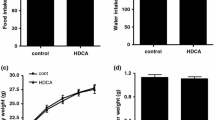Abstract
Cholesterol biosynthesis from acetate-2-14C by the livers of suckling rats, which is known to be relatively slow, was increased 2–3-fold within 24 hours after severing the bile duct. Cholesterol synthesis by sham-operated litter mates showed no change under similar treatment. Mevalonate biosynthesis from acetate-2-14C in vitro by recombined liver microsomal supernatant (105,000×g) fractions from suckling rats also was only 10% of that of comparable recombined fractions from normal controls (young adult rats which were consuming colony diet). Activity was not improved by combining either the microsomal or supernatant fraction from suckling rat livers with the complementary fraction from normal adult livers. On the other hand, activity was restored to 100% when microsomes from livers of duct-served suckling rats were combined with the supernatant fraction from normal controls. Likewise, recombined liver fractions prepared from adult rats fed synthetic diets exhibited low activity for mevalonate biosynthesis. Activity was restored by bile duct cannulation, but inhibited when cholic acid was infused into the cannulated animal. Therefore, surgical procedures which interrupt the enterohepatic recirculation of bile components lead to a restoration of cholesterol biosynthesis and, at least in the adult animal where cannulation studies are practicable, this effect can be reversed readily by bile acid infusion.
A slow rate of fecal excretion of14C-cholic acid was observed in suckling rats and rats fed synthetic diets, apparently reflecting an efficient enterohepatic recirculation of bile salts. The data suggest that under these dietary conditions bile salt retention either directly or indirectly influences hepatic synthesis of cholesterol.
Similar content being viewed by others
References
Carroll, K. K., Can. J. Biochem.42, 79–86 (1964).
Harris, R. A., J. E. MacNintch, and F. W. Quackenbush, J. Nutr.90, 40–46 (1966).
Bizzi, A. E. Veneroni and S. Garattini, J. Atheroscler. Res.3, 121–128 (1963).
Quackenbush, F. W., and M. Pawlowski, J. Nutr.72, 196–202 (1960).
Fimognari, G. M., and V. W. Rodwell, Science147, 1038 (1964).
Lowry, O. H., N. J. Rosebrough, A. L. Farr and R. J. Randall, J. Biol. Chem.193, 265–275 (1951).
Lynen, F., and M. Grassl, Z. Physiol. Chem.313, 291–295 (1959).
Rudney, H., J. Biol. Chem.227, 363–377 (1957).
Schlenk, H., and J. L. Gellerman, Anal. Chem.32, 1412–1414 (1960).
Busher, N. L. R., K. McGarrahan, F. Gould and A. V. Loud, J. Biol. Chem.234, 262–267 (1959).
Bucher, N. L. R., “Biosynthesis of Terpenes and Sterols,” Ciba Foundation Symposium on Biosynthesis of Terpenes and Sterols, edited by G. F. W. Wolstenholme and M. O'Conner, 1959, p. 46–61.
Siperstein, M. D., and M. J. Guest, J. Clin. Invest39, 642–652 (1960).
Siperstein, M. D., and V. M. Fagan, in “Advances in Enzyme Regulation” 2, Vol. 2., edited by G. Weber, 1964, p. 249–264.
Siperstein, M. D., and V. M. Fagan, J. Biol. Chem.241, 602–609 (1966).
Migicovsky, B. B., Can. J. Biochem.42, 105–110 (1964).
Lupien, P. J., and B. B. Migicovsky, Can. J. Biochem.42, 179–185 (1964).
Myant, N. B., and H. A. Eder, J. Lipid Res.2, 363–368 (1961).
Frantz, I. D. Jr., H. S. Schneider and B. T. Hinkelman, J. Biol. Chem.206, 465–469 (1964).
Tomkins, G. M., H. Sheppard and I. L. Chaikoff, J. Biol. Chem.201, 137–141 (1963).
Bloomfield, D. K., Proc. Natl. Acad. Sci. U.S.50, 117–124 (1963).
Fimognari, G. M., and V. W. Rodwell, Biochemistry4, 2036–2090 (1965).
Beher, W. T., G. D. Baker, W. L. Anthony and M. E. Beher, Henry Ford Hosp. Med. Bull.9, 201–213 (1961).
Siperstein, M. D., Am. J. Clin. Nutr.8, 645–650 (1960).
Portman, O. W., Am. J. Clin. Nutr.8, 462–470 (1960).
Carroll, K. K., Can. J. Biochem.42, 71–78 (1964).
Author information
Authors and Affiliations
Additional information
Presented in part before Federation of American Societies for Experimental Biology, Fed. Proc.24, 1078, 1965 (abstract). and in part at the AOCS Meeting, Los Angeles, April 1966.
Journal Paper No.2835, Purdue University Agricultural Experiment Station.
About this article
Cite this article
Harris, R.A., Rivera, E.R., Villemez, C.L. et al. Mechanism of suckling-rat hypercholesteremia. II. Cholesterol biosynthesis and cholic acid turnover studies. Lipids 2, 137–142 (1967). https://doi.org/10.1007/BF02530913
Received:
Issue Date:
DOI: https://doi.org/10.1007/BF02530913




